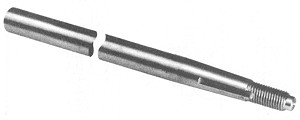Inboard Hardware: Propeller Shafts
Continued...
PROPELLER SHAFT MATERIALS
What is the "best" shaft material? This too depends on many variables, the first of which depends on if the boat will be used exclusively in fresh water, or whether it will be operated in salt or brackish waters. If the boat will be used in fresh water only, then corrosion problems may need little consideration, and consequently the propeller shaft will probably be cheaper. In salt water, however, various corrosion problems can occur making the selection of a suitable shaft material more critical.
 FIG. 10-1 - The typical propeller shaft
machined on the aft end for the propeller with a locking keyway, threads for
the nuts, and a hole for the cotter key. FIG. 10-1 - The typical propeller shaft
machined on the aft end for the propeller with a locking keyway, threads for
the nuts, and a hole for the cotter key. |
Some of the more common shafting materials will be described in the following. This listing is an attempt to provide practical information for the laymen and is not meant to be all-inclusive. An attempt has been made to list the materials with their common names and terminologies so as to not confuse the non-technical person. Basically, shaft materials are usually either of copper bearing materials or various stainless steels.
The common copper bearing metals used for propeller shafting are Naval brass (sometimes called "Naval bronze"), various bronzes, and Monel alloys. Naval brass contains about 60% copper, whereas bronze must contain 90% or more copper, and is therefore superior. Monel is a trade name for alloys containing about one third copper and about two thirds nickel. The 400 Monel and K-500 Monel are common propeller shaft types. The K-500 type is one of the strongest and most corrosion resistant of shaft materials, and consequently one of the most expensive. The 400 type is less costly and also not quite as strong, but offers good value. A common shaft material often specified is Tobin bronze (another trade name), but it is not as strong as the Monel materials, and not as suitable for exposed conditions.
Exposed steel shafting is not too commonly used, primarily because it will rust even in fresh water, and corrode severely in most marine applications. However, various stainless steels are commonly used. The various grades and types of stainless steel tend to confuse the ordinary person, and the authors apologize that there are only number designations to identify the suitable types.
The stainless steels often used for propeller shafts include Types 303, 304, 316, and 630. All stainless steel shafting is strong, especially the 630 type (which is also known as "17-4 PH"). Stainless steel shafting in salt water is more-or-less subject to pitting which leads to crevice corrosion. Types 303 and 304 are probably worse in this respect, with type 316 being less susceptible, and therefore better suited to salt water use. The 630 type is probably neck-and-neck with K-500 Monel at this stage in technology for the winner in the "best shaft material" race. It costs more than the other stainless types, is stronger, and is less subject to corrosion.
Stainless steel shafting has certain installation and usage requirements that should be adhered to for long shaft life. Sacrificial galvanic anodes should be located adjacent to or on the propeller shafts in salt or brackish waters, when the hull will remain in the water. If anode collars are used on the shafts, these may throw the shafts out of balance. Anodes of this type are also more subject to erosion than if located off the shaft. Take care to locate such anode collars so that they will not restrict the water flow to the propeller. In boats with a long shaft tube that will trap water next to the propeller shaft of stainless steel, there should be a means for providing a positive flow of water circulation in order to avoid the corrosive effects of stagnant water when in contact with stainless steel. All electrical equipment and all underwater equipment should be properly grounded to a negative ground underwater plate. These issues are not a serious concern on trailerable boats.
With shafting, the use of graphite packing or grease must be avoided to prevent pitting and subsequent galvanic corrosion. The shaft nuts, key, and cotter pin are preferably of the same or similar materials as the shafting. Most propeller shafts will be fitted with a standard taper at the end to suit the propeller. The standard taper is 3/4" to the foot, or 1/16" per inch. Because the propeller will be going in both directions (forward and reverse), a lock nut must be used, most often consisting of a nut with a jam nut plus cotter key. Some people try to get by with just a jam nut, or nut plus a cotter key. However, these same people often suffer the embarrassment of a lost propeller. While difficult to find, a coating of white lead is advised on the shaft under the propeller hub if of stainless steel or Monel to prevent corrosion between the shaft and the propeller, and to keep them from binding together, which can make removal difficult.
Much of what has been discussed is concerned with shafting for boats that remain in the water. Trailerable boats do not usually require galvanic anodes and maximum corrosion resistance is less of a concern for shaft material. High-speed planing boats will invariably use stainless steel and while more expensive materials like Monel may be "better", they are usually not required for the average ski boat. For most boaters, 303 or 304 are a good choice because of the economical price. Monel or 17-4PH shafting should be considered when a boat will operate at racing speeds or at higher speeds with long shafts without intermediate support.
More about Prop Shafts.